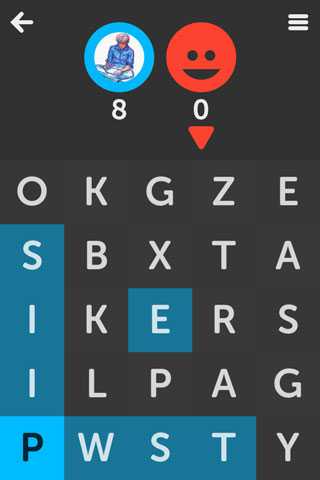Letterpress Strategy
Letterpress is a new game for iOS from Loren Brichter. Brichter rose to prominence after developing Tweetie. He was hired by Twitter, and left some time ago. Brichter has since revived his company Atebits, and Letterpress is his first app post-Twitter.
Gameplay
Letterpress is fairly straightforward, but a formal explanation of the rules can be found within the app. The basic rules follow, and more nuance can be discovered by reading through the rest of the post. At the game’s start you’re presented with a set of 25 letters presented on a 5X5 grid. Both players make words from these letters, and when a letter is used in a player’s word it changes to be their color. When all letters have been used to make words or both players pass their turns the game ends. Players win by having the majority of the tiles their color.
Some Terms
I’ve applied some terms to Letterpress, and made up some new definitions for them that I use to discuss Letterpress strategy. I haven’t heard anyone else use them in this way, so I’ll define them here.
Territory—A player’s territory consists of the letters surrounded on all sides by their color letters. Letterpress shows these tiles by coloring them with a tint or shade of the default tile color.¹ The letters in a territory will not change to your opponents color when they are used in an opponent’s word. For that reason we can consider them well defended.
Frontier—A player’s frontier consists of their tiles which are their color, but are not a part of their territory. These tiles will change if used by an opponent, and they can be considered poorly defended.
Where’s the value?
Letterpress is most easily won by locking up sections of the board. When a tile is surrounded by tiles of the same color it will not change to your opponent’s color if it is used in their word. By locking up sections of the board it is easier for you to maintain a lead in tile count, giving you an advantage in winning the game. The moves that deliver value are moves which maximize a player’s territory, and the easiest way to do that is to use the letters adjacent to the frontier. To deliver this value early we look to the edges of the board.
The Opening
The first moves of the game are the easiest when it’s time to start building territory. The average letter takes four adjacent letters to become part of a player’s territory, a letter on the edge takes three, and a corner letter takes only two.
Mid-board territory and frontier, edge territory and frontier, and corner territory and frontier.
That means that the best opening moves capture a territory, and that the easiest way to do that is to make an intial move in a corner, establishing a territory.
WISPIEST as an opening move, capturing a corner and and establishing a large frontier.
Expansion
The next moves are used to expand the territory, turning the frontier into territory by using the letters adjacent to the frontier to make words. This builds territory and limits the letters that your opponent can capture on their turn, thereby protecting a lead in letter count.
End Game
Once the game has only a few letters left it is in the winning player’s best interest to end the game quickly by capturing the last few remaining letters. This typically means that the winning player will be forced to make some awkward to clear off some uncommon letters (think Q, X, W, Y, Z, K, & J). This gives the losing player the opportunity to push into their opponent’s frontier and in a close game this gives them the chance to push the letter count into their favor.
The Takeaway
Use the corners. Make long words. Expand your territory. Don’t forget the prefix rule — add plurals, make adverbs, and add tense where possible. Finish the game.
I’m turning comments on for this post, if you have any Letterpress strategies that you’d like to share please post a comment.
Footnotes
1. The color of a player’s territory changes depending on the theme. In the default theme territories are darker, and in the Dark theme they are lighter.

